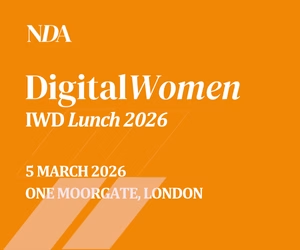Attention may be the talk of the town within digital advertising, but we’re still a long way from being able to utilise it in the most effective way possible, because nobody is quite sure what it is or what it will look like. And, in order to reach an agreed upon definition, the whole industry is going to have to work together.
The second part of NDA’s attention economy roundtable looks at the different roles that industry stakeholders have to play in the future of digital advertising. We, again, deliver you the wise words of Joseph Wood, Strategy Director, Spark Foundry; Amy Pearce, Sales Director UK, Teads; Nick Reid, SVP & Managing Director, DoubleVerify; Steve Richards, Data Partner, Wunderman Thompson; Niall Moody, Managing Director, Nano Interactive; Roxanne Harley, Director of Client Strategy, Azerion UK; and Rob Garber, Managing Director, GumGum.
The deprecation of third-party cookies has opened up the industry to thinking in new ways, and being more willing to collaborate with each other than in the past. It has also presented a number of questions around how audiences are engaged with, and how this engagement is measured.
Time for a change
DoubleVerify’s Reid questions how things have been done in the past, but also acknowledges the difficulties currently surrounding the idea of attention as a metric. He said: “For a long time, media has been planned and bought on things like reach and impressions. In the fragmented world we now live in, does that make sense? Clients are thinking about the deprecation of third-party cookies and compliance, but they’re also thinking about if their investment has been in the right place, and how they use the right metrics to determine this . Is that price? Is that an impression? Is that a view? Or is it a bit more sophisticated?
“The challenge with having attention as a metric is that none of us can actually define what attention is. You can optimise towards it through proxies or you can run brand studies. You can build a hypothesis around certain elements, and then optimise towards certain verticals. But your success can only be determined by o driving revenue return and uplift. That makes it hard to pin it back to a metric that you can charge.”
Wunderman Thompson’s Richards suggests there are “probably steps on the way to the attention economy” that should be actioned, but that it’s important not to get caught up in the idea of using automation for everything.
“We’ve quite quickly got into measuring everything impression by impression, almost like a programmatic answer,” said Richards. “But the first lever on it might be that you need bigger, more impactful formats, and you just need to shift your investment that way. That will be the first notch that will probably get you quite far on the attention piece. I don’t think the answer is always running an algorithm that you install.”
On the other hand, Nano’s Moody sees it as “an interesting step away from some of the outdated metrics”, and an opportunity to use the vast amounts of data and advanced technologies we have to reach a point where we can start to define attention.
“Attention is nothing new, but something that is new is our ability to look into data. There’s more data than has ever been there,” he explained. “If you were looking at that with machine learning techniques, and all the things that are available now that weren’t before, you could work out what the indicators are that work towards a proxy or an outcome, and repeat those over time.”
At the same time, despite being outdated, he doesn’t think that viewability should be seen as a negative. Moody added: “We talk about viewability like it’s a bad thing, but it’s not. It’s not the best thing that we’ve done, but it has improved the quality of inventory. Publishers have redesigned their sites, they’ve thought of new formats, and they’re doing cool things because, if they don’t do that, they won’t get money.”
Whatever the metric used is, the keys – according to Azerion’s Harley – are “knowing where your audience is going to be, where they’re spending their time, and what they’re reading”, and the creative that goes along with that.
“I think it’s really important that we align with what audiences want, because that’s more likely to deliver the business outcomes a brand is after. But we need to know who those audiences are going to be,” Harley stated.
“I think creative is our trump card. I hate to use cliché phrases, but creative is king. It really is. It comes down to the branding, the opinions that you’re creating around a product or message , and how you’re getting people to think, feel, and behave towards your brand.”
What a brand wants. What a brand needs.
Of course, much of this doesn’t matter if the brands aren’t invested in the idea of attention. Luckily, a number of brands appear to be willing to embrace it.
“Some of the bigger brands, who probably have a little bit more time and a little bit more money to spend, are delving into it,” said Spark Foundry’s Wood. “Generally, the more money being invested, the more impetus on proving it works. And that’s probably why we got to attention in the first place.
“We’re obsessed with measuring things and proving that things work. But some marketers and media professionals began to notice that some of the metrics being focused ondidn’t really correlate with or add up to what happens to the business metrics. The attention conversation comes from there being flaws in those metrics.”
As such, Wood sees attention as enabling the industry to “get back to quality and an end result that matters”, because “we’re getting to something that we know links to recall, and we know that recall links to strengthening of memory structures and brand health”.
Teads’ Pearce has also noticed “more questions around if attention can be bought”.
Yes, CPM is one of the best metrics to trade on, it gives you the most scale, and is a metric that is easily transferable. But we need to move from there, and see how we can better optimise toward aCPM (attentive cost per million) or aCPV (attentive cost per view). That would be my view. We should be going to advertisers and agencies and advising them that the old stuff isn’t broken. It still works really well. We just need to join up all the dots, because we have the data and availability in terms of learnings and measurement there.”
However, GumGum’s Garber believes that the industry should move to an aCPM, and that it “should be the lowest baseline, the standard”.
“I think aCPM should be something that we should offer with a standardised baseline , because any brand that wants to deliver a marketing message needs to get an eyeball on it,” he said. “Then it’s about how long I get that attention on there, the attention that I need, and what the value of the output of it is. But moving to that would be a purist view, because everything that is not attentive means it was delivered and paid for, but no one actually saw the ad.
“The first thing you do is have a baseline, like we have with viewability. Once you have a baseline, you have the standardisation, and then we can build off the back of it,” Garber concluded.










